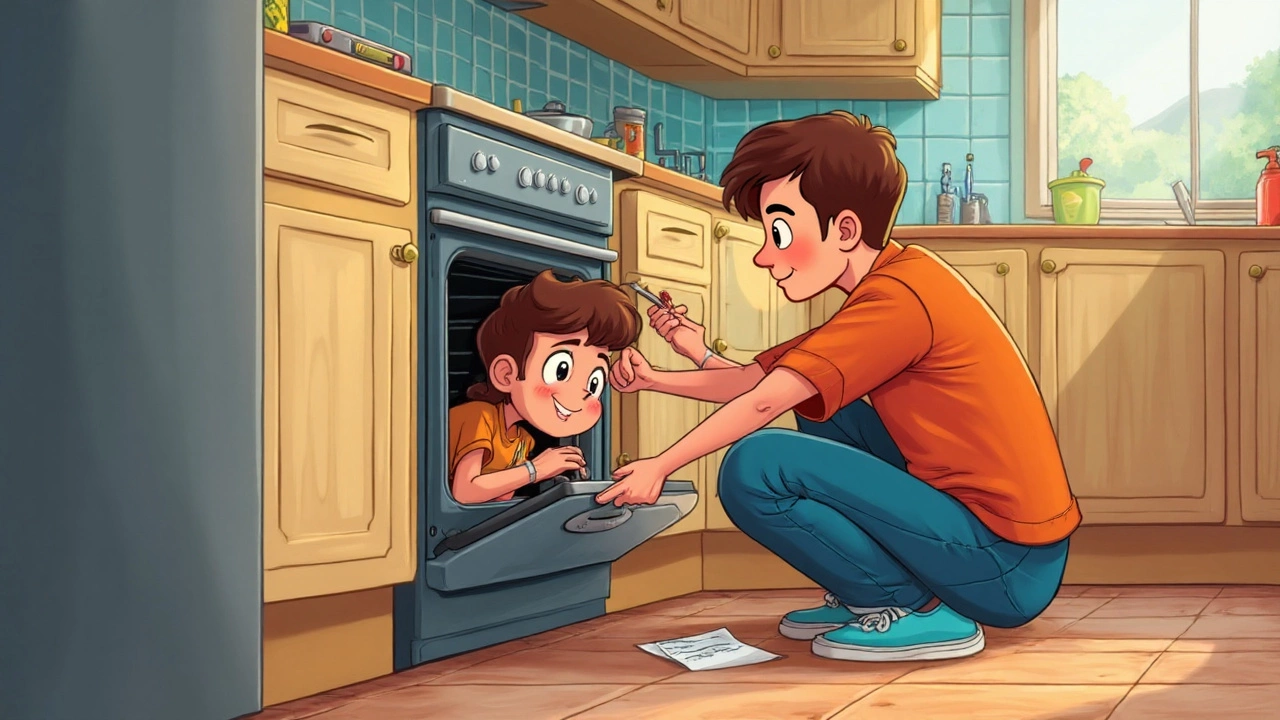Ever planned a family dinner only to realize your oven is acting up? It's just you and a perfectly seasoned roast that never gets cooked. Ovens break down at the worst moments. A surprising fact: about 40% of home appliance repair calls are for ovens, mostly for issues you can check yourself before calling a technician. Knowing how to troubleshoot your oven not only saves money—but also your dinner plans. Most of the time, the problem isn't a busted part. It's something simple like a loose connection, wrong setting, or that one cookie tray blocking a sensor.
Basic Checks Before You Dive In
Start with basics, because even the pros check the obvious first. Did you know one in five "broken" ovens sent for repair actually just weren't plugged in? Check that the oven is connected securely to its power source—for electric ovens, look for a loose or tripped breaker. Gas ovens? Make sure the supply valve is open and you can smell the faint whiff of gas when you try to ignite (but if it’s strong, ventilate and call for help). If your clock or display panel is blank, that's usually a power issue. Sometimes, unplugging the unit for a full minute lets it reset—electronics in today's ovens act up if there's a power surge or outage.
Take a look at the controls. Modern ovens have digital panels that sometimes get stuck in the wrong cycle, especially after a blackout. Press “cancel” or “off,” then try setting a basic bake function at 180°C (350°F). If the display flashes an error code, jot it down. Most manufacturers use specific codes for faults (e.g. F1, F3, E2). These codes are lifesavers, and you can usually find the meaning in your manual, or with a quick search online. If your oven lights won't come on, try swapping the bulb—not every bulb fits, so check your model. Sometimes, the glass light cover gets so grimy it blocks all the light. Give it a wipe while you’re at it!
Pay attention to the oven door. If it doesn’t close tightly, heat escapes, and you’ll wait forever for things to cook. A quick test: shut the door and gently tug to check for a firm seal. Most doors have a removable gasket—it’s like a fuzzy rope that lines the rim. If it’s worn, split, or missing chunks, you’ll need to replace it. Hidden crumbs and grease buildup also prevent the door from sealing. Use a damp sponge and a drop of dish soap to clear the groove. Still not closing quite right? Sometimes a hinge bends if someone leans on the open door. Carefully bending it back with pliers (wrapped in cloth) can help if you see it’s obviously out of place, but don’t force it if it seems risky; hinges can snap.

Troubleshooting Common Oven Issues
Oven not heating? Heating unevenly? That’s the most common problem, and the likely culprit is a faulty heating element or temperature sensor. If your oven’s electric, look at the coils when you set it to bake—do they glow red hot? If not, you can do a quick test with a multimeter. First, unplug the oven, then remove the back panel. Touch the meter’s probes to each end of the element. If you get no reading, the element is fried. Replacements aren’t expensive—most cost under $30 as of a 2024 survey. Swap it by loosening a couple of screws and sliding on the new one.
For gas ovens, the igniter is usually the snag. Set the oven to bake and check if the igniter glows. If it glows but the gas never kicks in, the igniter is too weak to open the valve. Again, replacing this part at home is often easier than people think. Just remember to turn off the gas and unplug the oven first. While you’re inside the oven, check that the burners aren’t clogged. A sticky or yellow flame means carbon buildup or blocked holes; brush them gently with an old toothbrush. Always avoid pins or sharp metal—just use something nonmetallic, like a wooden toothpick.
Here’s a handy stat: about 18% of oven repairs are for uneven cooking. If your cookies burn in the back but are raw in the front, you could have a problem with the convection fan. Electric convection ovens use a fan to move heat around for even cooking—if it’s not spinning, check for obstructions (sometimes a stray popcorn kernel wedges in). No noise from the fan at all? The fan motor might need replacing, and this does take a bit of mechanical confidence. That said, a dead fan doesn’t totally ruin your oven; you’ll just need to swap pans or rotate your dish halfway through.
If you notice your oven thermometer doesn’t match what your oven says, it could be a failing thermostat or sensor. These thin rods or metal bits usually stick out inside the oven cavity and plug into the wiring at the back. Use a basic thermometer (less than $10 and sold at any home store) to check how far off your oven runs. If you see a consistent difference of 10°C (or 20°F) or more, it’s definitely time for a sensor swap. And don’t forget the settings: sometimes ovens are accidentally set to Celsius when you’re expecting Fahrenheit, so double-check on the panel.
| Issue | Likely Cause | Simple Fix |
|---|---|---|
| Oven won’t turn on | No power, loose plug, tripped breaker | Check power, reset breaker, secure plug |
| No heat/elements not glowing | Burnt heating element, faulty igniter | Test/replace element or igniter |
| Uneven cooking | Convection fan broken, blocked air | Clear obstructions, repair/replace fan |
| Blank display | Blown fuse, no power | Check fuse, reset electronics |
| Oven light not working | Dead bulb, dirty cover | Replace bulb, clean lens |

When to Fix, When to Call for Help, and Tips to Keep Your Oven Running
Sometimes, a problem is just beyond a simple home fix. If you smell strong gas or see sparks, step back and call in a pro. The same goes if you see blackened wires or melted parts behind the panel—fire risk is serious. A fun fact: the average age of an oven needing a major repair is about 9 years. Replacing smaller parts like elements, bulbs, or door gaskets is usually worth it, but if your oven’s pushing fifteen, consider putting that repair money towards a new, more efficient model. Newer ovens use up to 30% less energy than models from the 2000s, so you’ll make up the cost in lower bills.
Let’s talk regular care. Wipe up spills as soon as the oven cools. Sticky sugars burn up and turn into hard, carbon-like spots, which eventually block fans and sensors if left alone. Use the self-clean function—but only a couple times a year. High-heat cleaning cycles wear hard on electronics and can cause glass doors to crack, especially on cheaper brands. Instead, scrub with a baking soda paste and let it sit overnight on trouble spots, then wipe away the goop. Never take the door apart unless you see visible gunk inside; it’s easy to trap moisture and damage the window if you’re not careful.
Check the manual for your make and model—or download it online if you lost the original. Manuals often include parts diagrams so you know exactly what you’re looking at. When buying replacement parts, use your oven model number. Generic parts can save money, but always triple-check dimensions and ratings. One last tip: keep an oven thermometer in place, even after you fix things. This gives you a backup warning if something starts to go off again. Sharing your oven troubles with a repair tech? Be specific with error codes and steps you’ve taken—that speeds things up and sometimes gets you free advice.
If you keep your oven tidy, fix the tiny irritations, and watch for warning signs, you’ll almost always keep it running until you’re ready to choose new features, not just because something broke. And with a little troubleshooting, chances are your next repair will be as simple as swapping a bulb or tightening a wire.


